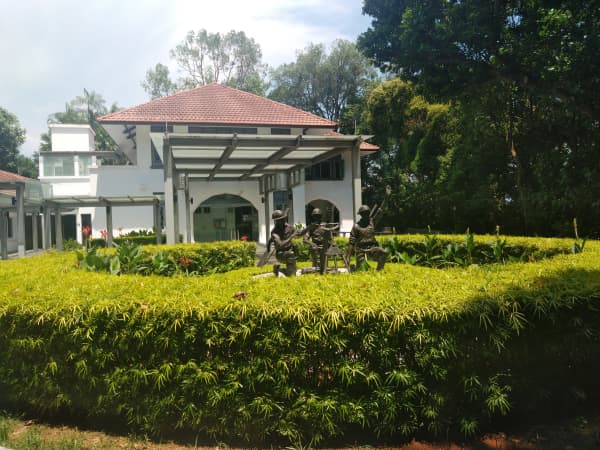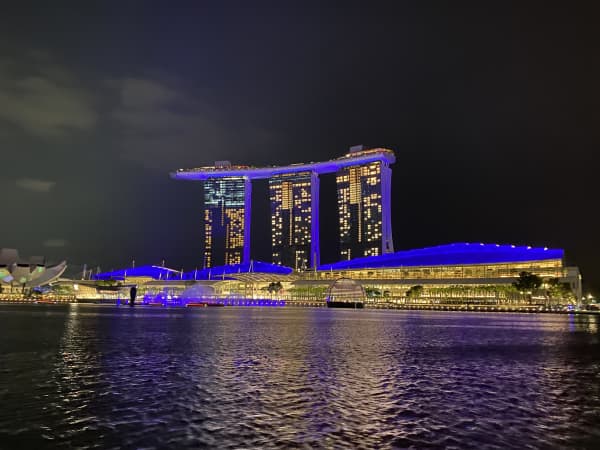2024 Premier’s Anzac Student Tour
2024 Premier’s Anzac Student Tour
The Premier’s Anzac Student Tour travelled to Singapore in April 2024.
Accompanied by 3 teachers, the group of 10 students departed for the 10-day tour on 5 April.
The 2024 program gives students a unique opportunity to investigate the Anzac legacy, find out more about those who served in the armed forces, and commemorate the 82nd anniversary of the fall of Singapore and 106 years since the signing of the Armistice.
A selection panel has selected students as tour ambassadors based on a written submission and interviews that demonstrate their interest in Australian history and understanding of the Anzac legacy.
- Tour diary, Day 9 and 10: Singapore's Total Defence
- Tour diary, Day 8: Kampong Glam, Gibraltar Crescent, and Sembawang
- Tour diary, Day 7: Australian High Commission
- Tour diary, Day 6: Changi Beach and Singapore Navy Museum
- Tour diary: Day 5: Fort Pasir Panjang and Sentosa Island
- Tour diary, Day 4: Ford Factory and Kent Ridge Park
- Tour diary, Day 3: Professor Brian Farrell and Sarimbun Beach
- Tour diary, Day 2: Exploring Singapore and the National Museum
- Tour diary, Day 1: Arrival
- Tour participants
Day 9 and 10 by Aja Kondo-Morcom, Year 10, Mount Lawley Senior High School
When we all woke up on Sunday morning, it was hard to ignore the bittersweet feeling that the day would be our last full day in Singapore, and with each other. At least for a while. The trip had been an absolute rollercoaster. We had our highs and, of course, a couple lows, but we knew that even though we were exhausted, we had to make the most of our ‘last’ day.
We started with an early morning breakfast, which some of us may have struggled to wake up to, before heading off to a 3-hour walking tour with Lion Heartlanders about Singapore’s Total Defence. Total Defence revolves around the idea that all aspects of Singapore’s society contribute to its defence, and that they can defend against all forms of attack, military and non- military. This is outlined in the 6 pillars of Total Defence: military, civil, economic, social, psychological and the recently added digital defence.
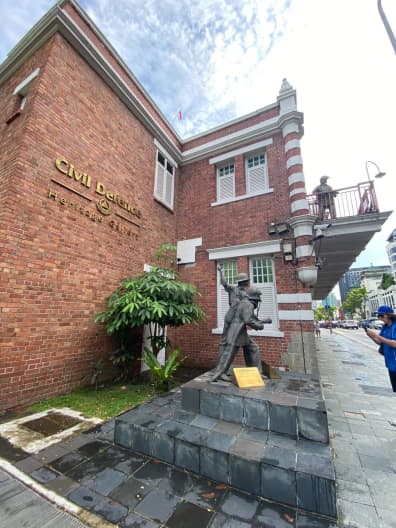 Our tour guide, Ganesh, walked us to a building, statue, or memorial that encompassed each pillar of defence, explaining what it is and how it contributes to Singapore’s defence. I personally found it most interesting learning about civil defence at the Hill St Fire Station, as it wasn’t the first thing I thought of when thinking about Singapore’s defence. It also surprised me when Ganesh mentioned that he, like many others, served their national service in civil defence (emergency services such as police, fire and ambulance) instead of the military. Some other locations we visited included the Padang, an Armenian church, Parliament House, the old City Hall and a statue of Sir Thomas Stamford Raffles.
Our tour guide, Ganesh, walked us to a building, statue, or memorial that encompassed each pillar of defence, explaining what it is and how it contributes to Singapore’s defence. I personally found it most interesting learning about civil defence at the Hill St Fire Station, as it wasn’t the first thing I thought of when thinking about Singapore’s defence. It also surprised me when Ganesh mentioned that he, like many others, served their national service in civil defence (emergency services such as police, fire and ambulance) instead of the military. Some other locations we visited included the Padang, an Armenian church, Parliament House, the old City Hall and a statue of Sir Thomas Stamford Raffles.
This tour was a great conclusion to the past nine days, learning about Singapore and its role during the Second World War, with each day of our tour taking us through a different part of Singapore’s history. We explored in depth the landing of the Japanese forces on Sarimbun Beach, the British defences of Singapore, the fall of Singapore and subsequently the life of prisoners of war, the Japanese occupation, and how, by preserving their history, Singapore has evolved to be independent in their own defence and cultivate a society rich in culture.
With our own research projects, we got to follow the journeys of family who fought in the war, or anyone else who contributed to the war efforts that caught our interest. Harry Tysoe, Vivian Bullwinkel, James Douglas Beazely and Henry Arthur Marsh were just a few of the people we researched.
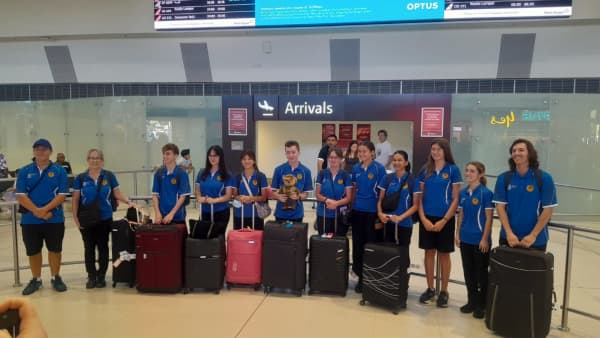 As our time came to an end, we boarded our plane and took the 4.5 hour flight back to Perth. We took a couple of final photos at the airport and said our goodbyes, taking with us the knowledge we now had, unforgettable memories and the amazing friendships we formed.
As our time came to an end, we boarded our plane and took the 4.5 hour flight back to Perth. We took a couple of final photos at the airport and said our goodbyes, taking with us the knowledge we now had, unforgettable memories and the amazing friendships we formed.
Day 8 by Avery Flint, Year 10, Applecross Senior High School
As day 8 rolls around, the unfortunate end of the Premier’s Anzac Student Tour 2024 is in sight. However, this only serves as another good reason to make the most out of the eventful day. Today, we embarked on a journey to the cultural markets of Kampong Glam, the Sembawang shipyard, Gibraltar Crescent, and Sembawang hot spring park.
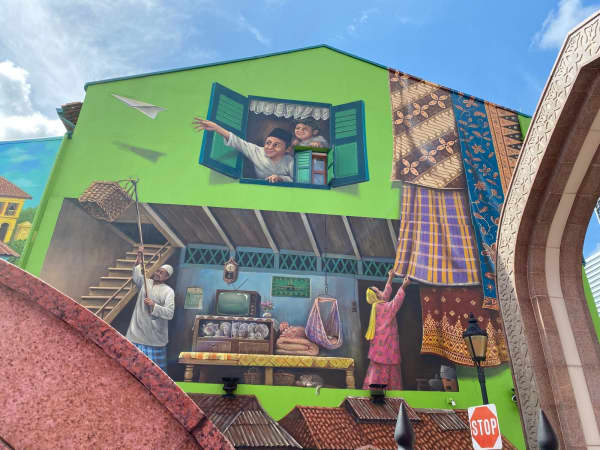 To travel to Kampong Glam, we were required to take the Mass Rapid Transit (MRT) system, which was a first for most in the group. We found it was pretty similar to Perth’s train transport system, but more organised and safer in the station, more crowded in the train, and travelled at a higher speed than we are used to. As for Kampong Glam, it was a reminder of the cultural blast we experienced on the first day of arrival.
To travel to Kampong Glam, we were required to take the Mass Rapid Transit (MRT) system, which was a first for most in the group. We found it was pretty similar to Perth’s train transport system, but more organised and safer in the station, more crowded in the train, and travelled at a higher speed than we are used to. As for Kampong Glam, it was a reminder of the cultural blast we experienced on the first day of arrival.
We were once again on its narrow streets with touristy and culture focused shops surrounding us along with special murals that depicted its busy shop windows. We looked around buying gifts for ourselves or those who we appreciate. We also explored inside an Islam Mosque, where the guys wore sarongs and women wore long skirts to cover up their legs out of respect for the traditions of the mosque. We discovered the mosque had a large carpet area to pray on, and the whole building felt calm and relaxed, as tourists and locals moved through the mosque peacefully.
The Sembawang shipyard, took the group to the coastal area of the island. The area, like most in Singapore, was filled with greenery and appeared to be a nice park location, though kites and certain dogs are prohibited. From the beach, we were looking into the ocean strait, with Malaysia right in our sight. There were big ships on one side of our view and ocean with protective blue barrels to prevent boats from coming in, on the other side. We learnt that the yard used to be a naval base, with its construction being completed during 1938. It was expected to be built in 7 years, but ended up taking more than 17 years, with its delay primarily due to a government budget issue (original budget was 4 million pounds but it ended up costing 28 million pounds), and a holy Karma tree that was worshiped by the Asian culture and was refused to be cut down for the base’s construction. This problem was solved, as there was a peaceful ceremony for the tree’s removal. The base was built to accommodate the Royal Navy and protect Singapore from a back door attack from the Japanese, with the British Prime Minister certain that the base heavily contributed to making Singapore ‘impregnable’, but as we know, it only took the Japanese 7 days to defeat the allied forces in Singapore, causing the Sembawang dock to close in 1942.
Our bus drive through Gibraltar Crescent revealed all the black and white bungalows that still stand in the isolated and quiet area. We discovered they were built to house officers, on streets named after the royal family and that some sat on stilts depending on the terrain, as this design would improve ventilation. Once again, heavy greenery and nature surrounded the houses, however, there was a change in setting, with there being no giant skyscrapers near the houses. Some houses were in disrepair, but some were in good condition, with modern day families still occupying them and even basketball hoops out the front of the houses. We could clearly feel the old colonial presence in the area and the influence the time period had on the architecture.
 We finished off our main activities for the day with an intriguing visit to Sembawang hot spring park. The park was located on a beautiful area of land, with unique trees and plants, such as hibiscus and jackfruit, appearing all around us as we headed down to the hot spring. It was surprising to most of the group to see that the hot spring was in a concrete fountain structure, and not just in nature. We attempted to cook eggs under the hot water of the hot spring egg cooking station, but they didn’t quite become solid in the time we had available. Nonetheless, it’s the memory that counts and we all enjoyed testing the hot spring water out by putting our legs in ankle deep for a reasonable amount of time. We learnt that 4 hot springs were discovered in 1908 by a ranger. The water can reach up to 100 degrees Celsius, which is around 70 degrees higher than a hot shower!
We finished off our main activities for the day with an intriguing visit to Sembawang hot spring park. The park was located on a beautiful area of land, with unique trees and plants, such as hibiscus and jackfruit, appearing all around us as we headed down to the hot spring. It was surprising to most of the group to see that the hot spring was in a concrete fountain structure, and not just in nature. We attempted to cook eggs under the hot water of the hot spring egg cooking station, but they didn’t quite become solid in the time we had available. Nonetheless, it’s the memory that counts and we all enjoyed testing the hot spring water out by putting our legs in ankle deep for a reasonable amount of time. We learnt that 4 hot springs were discovered in 1908 by a ranger. The water can reach up to 100 degrees Celsius, which is around 70 degrees higher than a hot shower!
All in all, today was a very insightful and engaging day for the tour group. As the end of the tour draws near, our group finds itself truly valuing the time we have left together and in Singapore.
Day 7 by William Temby, Year 12, Margaret River Senior High School
 Our next stop was the Australian High Commission where we learnt of the various roles and responsibilities carried out by them. Our first thoughts when it comes to the role of a High Commission would likely relate to passport and immigration-related consultations, and while that is a notable component, they also play a role in defence, foreign affairs, trade, and health. Graham Dickson and Peter Brine’s amazing level of knowledge and detail led to an extremely engaging presentation that served to create an extremely memorable experience.
Our next stop was the Australian High Commission where we learnt of the various roles and responsibilities carried out by them. Our first thoughts when it comes to the role of a High Commission would likely relate to passport and immigration-related consultations, and while that is a notable component, they also play a role in defence, foreign affairs, trade, and health. Graham Dickson and Peter Brine’s amazing level of knowledge and detail led to an extremely engaging presentation that served to create an extremely memorable experience.
Up until recently, there were several war memorials and cemeteries spread across Singapore, each with the role of commemorating the fallen allied soldiers during World War Disputes, all of them being extremely significant and important. The fact that they were all built to serve the same purpose convinced the Singaporean government to exhume all the bodies and move them to Kranji Cemetery which now serves as the final resting place for 4,458 people who served and fought for the allied forces during the First and Second World War. Our journey there was full of mixed emotions. The contrasting atmosphere of the beautiful hills and trees juxtaposed with the sheer volume of graves, all symbolising a person with a family and people who loved them who left this earth due to war really emphasises the cost of war. The true cost of war. You can feel it as you walk through the rows upon rows of headstones, an experience that mere figures and statistics in history textbooks really cannot do justice. The amazing ceremony conducted by Tim and Milla strongly contrasted, but also complemented, the heavy atmosphere of the cemetery. Milla presented a clever selection of poems written by prisoners of war at Changi. It was masterfully produced and executed in the way that invoked a sense of national pride and what it means to be Australian, but also of what we need to uphold in order to preserve our brave, young soldiers’ legacy and Australia’s place in the world that was fought and died for. We must not let them die in vain.
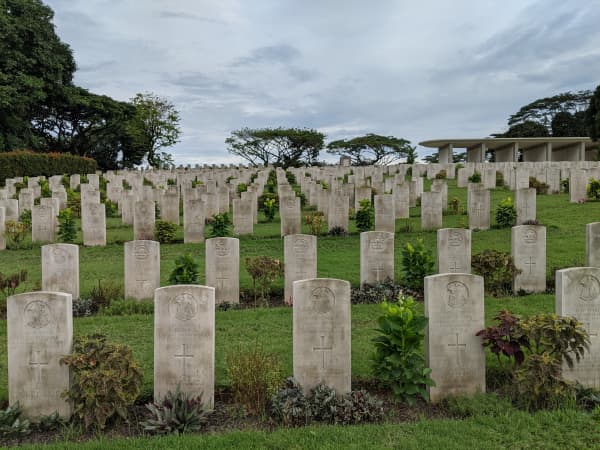 Overall, the extremely interesting and educational presentation at the High Commission was an amazing experience that taught us a lot about completely unexpected roles that many of us didn’t even know they were involved with. The amount of understanding you gain from going to a place yourself and talking to the people who work there leads to a far greater understanding and appreciation for the work people do there. Similarly, with Kranji Cemetery, the way we’re able to properly visualise the cost of wars and the impact they have on peoples’ lives is an experience that cannot be replicated exclusively in a classroom environment and can only be experienced by seeing it yourself.
Overall, the extremely interesting and educational presentation at the High Commission was an amazing experience that taught us a lot about completely unexpected roles that many of us didn’t even know they were involved with. The amount of understanding you gain from going to a place yourself and talking to the people who work there leads to a far greater understanding and appreciation for the work people do there. Similarly, with Kranji Cemetery, the way we’re able to properly visualise the cost of wars and the impact they have on peoples’ lives is an experience that cannot be replicated exclusively in a classroom environment and can only be experienced by seeing it yourself.
Day 6 by Freya Hicks, Year 11, Christmas Island District High School
 Day 6 of the Singapore experience saw an onset of information regarding the life of Prisoners of War (POW) and the horrors they faced. We began the day at Changi Beach, one of the many Sook Ching Massacre sites, where the military operation to ‘purge’ or ‘cleanse’ those of Chinese descent took place. Standing on the same ground as the massacre victims, those innocent Chinese civilians, was surreal and deeply moving. It emphasised the importance of visiting historical sites that foster genuine connections and bring a sense of reality to horrific situations.
Day 6 of the Singapore experience saw an onset of information regarding the life of Prisoners of War (POW) and the horrors they faced. We began the day at Changi Beach, one of the many Sook Ching Massacre sites, where the military operation to ‘purge’ or ‘cleanse’ those of Chinese descent took place. Standing on the same ground as the massacre victims, those innocent Chinese civilians, was surreal and deeply moving. It emphasised the importance of visiting historical sites that foster genuine connections and bring a sense of reality to horrific situations.
Next on the agenda was the recently established Singapore Navy Museum, providing an amazing insight into a topic that we hadn’t delved into in much depth prior to the visit. I was quite intrigued when voyaging through Singapore’s naval history; beginning as early as 1300 with the Orang Laut ‘sea peoples’ occupying its water, to the arrival of Sir Stamford Raffles and William Farquhar who established a free port policy. Singapore Port is the world’s largest transhipment hub, connecting more than 600 ports from 123 countries. The development of Singapore’s navy and technological advancements, including harpoons, torpedos and vigorous recruit training, has reinforced its position as an international trading hub.
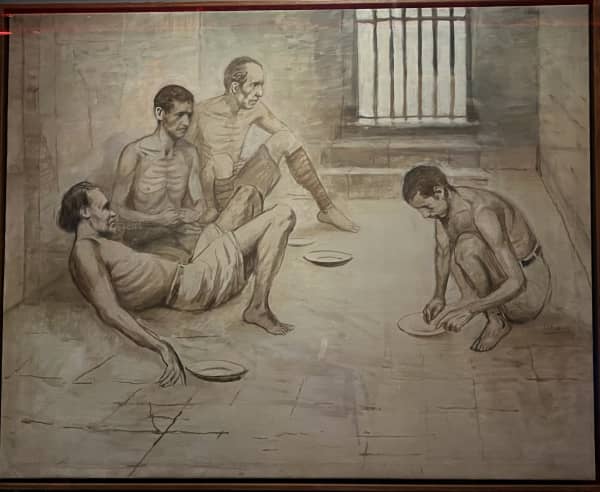 Moving away from Singapore’s coast and inland provided us with the opportunity to see the infamous Selarang Barracks, but only from the bus. Unfortunately, access is prohibited as part of the Changi Prison complex. However, just by seeing the barracks, we could envision the Australian POWs tirelessly working under the battering sun and watchful eyes of vigilant Japanese soldiers.
Moving away from Singapore’s coast and inland provided us with the opportunity to see the infamous Selarang Barracks, but only from the bus. Unfortunately, access is prohibited as part of the Changi Prison complex. However, just by seeing the barracks, we could envision the Australian POWs tirelessly working under the battering sun and watchful eyes of vigilant Japanese soldiers.
Many captives had put pen to paper during their time at Changi Prison, materialising their moments of freedom, at the Changi Chapel Museum which we visited next. The artistic outlet and talent of some of the POWs were truly incredible, depicting a tragic time in history in such an elegant, inspiring way. The notion of creativity in adversity was exemplified by these POWs, creating makeshift chalk paints, scavenging for scrap materials and musical instruments to add purpose to their days and a glimpse into their lives.
In one instance, quilts known as ‘the Changi Quilts’ were created by intern women at Changi Prison. The quilt contained a coded message from imprisoned men who wished to send their wives and children news of having survived. All in all, today proved to offer a strong emotional connection to the various sites and museums we visited that highlighted the immense courage, bravery, and sacrifice of so many who suffered the war’s atrocities.
Day 5, Keona Latiff, Year 10, Canning Vale College
 Day 5 of our tour was a much-appreciated change in weather, as heat of the day before was less evident, though the humidity remained. Perhaps this was due to our generous shelter in the vast greenery and foliage of Labrador Park. We were in absolute awe and wonder at its beauty. Unlike all the forts we had been to so far, the fort interior of Labrador Park (Fort Pasir Panjang) was the first we were unable to explore. Our tour guide, Rayney, explained that although the fort had been open once, damage from tree roots in surrounding areas had affected the smooth maintenance of the electrical systems, and was ultimately too difficult to manage. The gates were still open, but possible snake nests and other threats prompted strong discouragement for the public to explore the tunnels on their own.
Day 5 of our tour was a much-appreciated change in weather, as heat of the day before was less evident, though the humidity remained. Perhaps this was due to our generous shelter in the vast greenery and foliage of Labrador Park. We were in absolute awe and wonder at its beauty. Unlike all the forts we had been to so far, the fort interior of Labrador Park (Fort Pasir Panjang) was the first we were unable to explore. Our tour guide, Rayney, explained that although the fort had been open once, damage from tree roots in surrounding areas had affected the smooth maintenance of the electrical systems, and was ultimately too difficult to manage. The gates were still open, but possible snake nests and other threats prompted strong discouragement for the public to explore the tunnels on their own.
After this, we drove across to Sentosa Island, now a tourism resort, housing attractions such as 5-star hotels, a casino, and perhaps more commonly known, Universal Studios Singapore. However, our group’s intention on the island was to visit the historical Fort Siloso, twin fort of Labrador Park, both dedicated to defend Keppel Harbour in the event of a Japanese attack. We were able to visit the inside of the fort and learn of its history during the war.
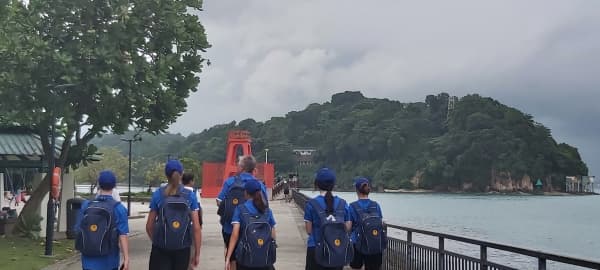 Lifelike wax figures, accurate equipment and furniture replicas in various buildings aided our visualisation of what the fort would have looked like during the war. In one of the last rooms before the exit, we saw pictures of the Prisoners Of War in Fort Siloso during the Japanese occupation. Our collective reaction was one of shock and horror at the awful conditions soldiers endured during the fort’s time as a POW camp. Despite their awful treatment, most soldiers appeared to stay cheerful. Their unwavering hope and optimism for a better future was incredibly inspiring.
Lifelike wax figures, accurate equipment and furniture replicas in various buildings aided our visualisation of what the fort would have looked like during the war. In one of the last rooms before the exit, we saw pictures of the Prisoners Of War in Fort Siloso during the Japanese occupation. Our collective reaction was one of shock and horror at the awful conditions soldiers endured during the fort’s time as a POW camp. Despite their awful treatment, most soldiers appeared to stay cheerful. Their unwavering hope and optimism for a better future was incredibly inspiring.
Later that evening, we went to Gardens by the Bay and Marina Bay Sands, both sights we viewed from afar on our cruise earlier in the week. It was amazing to see these attractions so close up. The music-light show at Gardens by the Bay was breathtaking, and we were treated to another light show at Marina Bay Sands shortly after. It is no wonder they are icons of Singapore. Absolute beauty and magnificence, an excellent view to conclude our day.
Day 4 by Caitlyn Willis, Year 9, Guildford Grammar
Today's visits to the Ford Factory and Kent Ridge Park on our Anzac tour were eye-opening, moving, and emotional. We began at the Ford Factory, which played a pivotal role in the Fall of Singapore during the Second World War. The detailed projections and historical accounts provided valuable insights into the strategic importance of this site and the fierce battles that unfolded there.
It was sobering to learn about the ultimate surrender of the British, Australian, and other Allied troops, despite their valiant efforts to defend the city. We got to stand exactly where the surrender took place. This was really fascinating for me because we learnt that Japanese General Tomoyuki Yamashita did not look down when confronting opposing General Arthur Percival in the surrender room. General Percival never looked up at Yamashita and only looked left, right or down, this just shows how confident Yamashita could afford to be. Despite decades between now and the event, when I was standing in the room, I could really feel the tension as if they were still there.
In the afternoon, we visited Kent Ridge Park and the historic bungalow, Reflections of Bukit Chandu (Malay for Opium Hill), which is now a museum that explores the role of the Malay regiment in the defence of Singapore as well as the nearby Opium factory during the Colonial era. This was another eye-opening aspect of our tour, as we delved into the complex social and economic forces that drove the opium trade and its success. The area that is now Kent Ridge Park was originally a lowland evergreen rainforest. In the early 19th century, settlers began growing crops like rubber, pepper, gambier, and pineapple on the ridge. During World War II, the British used Kent Ridge as a fortress to defend Singapore against the Japanese invasion. A key battle, known as the Battle of Bukit Chandu took place on the hill in Kent Ridge Park between the Malay Regiment and the invading Japanese forces.
Overall, today's visits have provided me with a more nuanced understanding of this critical chapter in Singapore's history. The depth of knowledge and attention to detail conveyed by George, our guide, was impressive. I appreciate the opportunity to walk in the footsteps of those who lived through these events. I remain grateful for the chance to gain a deeper appreciation for the sacrifices and struggles of the past, even if it can be uncomfortable and confronting at times.
Day 3 by Tim Kania, Year 12, Aquinas College
Day 3 has been the best by far in my opinion, we had a whole six hours given to listening to Professor Brian Farrell from the National University of Singapore about the Fall of Singapore and the events leading up to and caused by it. I say it was my favourite as it was the first purely historical talk we’ve had on the tour which is the main part that interests me. Another reason it was great was because I was able to sit, listen and ask questions to someone who has been dedicating his life to the field of historical research in the Pacific region and had the ability to give answers that easily clarify any outstanding questions or thoughts I had. One of the new things I learnt was the Pacific China Nexus plan set up by the British in the lead-up to the Pacific Theatre becoming a warzone. It was a strategy devised by the British saying how they didn’t have the huge naval advantage over the Japanese that they used to, so they had to try and build infrastructure and fortifications to make best use of what they had; some of these structures included the ports at Singapore, Java and Ceylon in Sri Lanka, which would later become the primary port of the Far East Asia Fleet.
Following on from the lecture, Professor Farrell took us to Sarimbun Beach on the north-west coast which was one of the first sites that was hit by the Japanese during the invasion of Singapore. I never understood how close the Japanese were to Airfield Tengah after landing and how easily they had access to the base from both marshy forest terrain and open roads allowing for more creative approaches when moving towards the airfield. For example, combining both the static movement of armour and the faster, lighter movement of Infantry without having any of the negatives as they supported each other in very close proximity.
I really appreciated the time that Professor Brian Farrell spent with us, and how clearly happy he was to be sharing this information with a group of students that were interested in the subject.
Day 2 by Milla Lobik, Year 10, Applecross Senior High School
Today, we all awoke to beautiful sunshine, which we enjoyed by the pool until we left for Orchard Road Shopping Mall. The road obtained its name for being an old nutmeg plantation – some trees still exist today! We learned this while wandering through the luscious gardens that were boasted at Fort Canning Park. Here, not only did we discover the significant war site, but we also saw the Battlebox bunker under the hill that the English used to plot and fight against the Japanese in the Second World War. Venturing through the rooms, we saw the plotting room, filtration room and the cat ladder that would be used to escape, if ever necessary.
Did you know Singapore became independent in 1965 after becoming a crown colony in 1867? We ventured through the National Museum of Singapore and discovered the chapters to the country’s vast story. We spent some time reading about its colonisation, and the two men responsible for this: Sir Stamford Raffles and Major William Farquhar. Raffles wrote a treaty, in multiple languages including Jawi, that opened ships of every nation to trade free of duty. This made Singapore come alive with immigrants, culture and prosperity as it flourished on its Malayan rubber and tin.
The National Museum not only told the birth of Singapore but also the horrors it had hosted. The Fall of Singapore saw much hardship with 130,000 prisoners of war in the hands of the Japanese. They were placed in Changi Prison which acted as a place to pass through temporarily before being forcibly moved to destinations along the Thai-Burma railway and other Japanese territories. Amongst the other horrors was the mistreatment and massacre of the Chinese population under Japanese occupation in a period known as the Sook Ching (‘great purge’). This occurred to identify and eliminate anti-Japanese threats; however, others argue it was for racist beliefs. This resulted in Chinese men aged 18-50 having to register at screening centres, where those amongst them who had tattoos, supported Chinese Relief Funds or the Singapore Volunteer Corps all found themselves meeting a grim fate. Unofficial estimates believe 20,000 to 30,000 were killed, with recovered objects like baby bracelets and earrings showing that women and babies were also killed.
After spending some time at the museum, we left to go to the Dynasty Plaza for a tasty meal. With our bellies full, we got to enjoy a lovely bumboat cruise along the Singapore River. We were fortunate to learn about the river and how it originally hosted many ships for trading and was full of litter due to being used as a bathroom. However, knowing the river was in the heart of the city, a plan was quickly put into action taking ten years to clean the river. Now, people like us have the pleasure to cruise down the river and view the monumentally tall buildings that tower above our heads and be in awe of the light show played at Marina Bay Hotel.
Day 1 by Mazlyn Membry, Year 10, Manjimup Senior High School
We arrived at the airport, all equally weary, yet ecstatic for the journey approaching. The airport had a disorientating aura of dystopia in the early hours of 3:30am, however as we met with everyone, and pushed through the bag checks (at the loss of a few bottles of liquid) we eventually boarded, and were finally approaching our final destination.
Immediately after we were to set foot outside of the cool air conditioned airport, it were as if the humidity had smacked us in the face. The unpleasant feeling of constant sweat in the 33-degree heat was overwhelming and foreign, although simply a joy of the cultural experience of Singapore. Boarding the bus and meeting George, our witty and intelligent tour guide, who would show us through the cultural tour.
The cultural tour began in Little India, where we were dropped off with only our bags and the tour guide. Immediately, we were struck with a plethora of smells, colours and an overstimulation of sights. It finally felt as if we were in a different country. Amongst the rainbow of shops and stalls were the Southern and Northern Indian temples. I was completely enraptured by not only the interesting ideas and stories of the Gods and Goddesses of the Northern temple, but the pure time and effort they dedicate to the intricate design of metallics (silver and gold) to highlight the richness of the gods, prayer and offerings of milk (said to have soothing and purifying properties) and flowers to the deities. Live Indian instrumental music was performed at the temple, solidifying the unique foreign aura of Little India.
Chinatown was next. As we walked through the crowded streets, we shifted our gaze to the top floors of the shops, which were the original buildings and rooms, opium dens in which opium was traded and smoked. After stopping by the incredible infrastructure of the Chinese temple, we ventured down Japanese street, where George had told us interesting stories of Japanese spies disguised as prostitutes, and the Opera house where the rich and famous would go to gamble and drink, and later bombed by the Japanese.
Day 1 was an insightful and entertaining introduction to the cultures of Singapore with a wide variety of information to initiate the tour.
Day 1 by Tahlia Watson, Year 10, Geraldton Senior High School
We started the day very early, meeting at the International Airport in Perth at 3am. Finally, we were on our way to Singapore. We started our adventure by going on a cultural tour to Little India, Kampong Glam and Chinatown. We explored the various religions, cultures, and practices, for example, Sri Veeramakaliamman Temple in Little India. The music was loud, yet coordinated and unique, and the temple was full of colour. Everyone wore saris, the traditional Indian clothing. People prayed to their gods and made offerings, such as flowers, money and even milk, which was a surprise to us.
Chinatown was very intriguing, we learnt about the history of all the buildings, such as the restaurants that had homes on the second floor, which used to be very common when Chinese immigrants arrived in Singapore. We also looked at their temple, which was beautiful, and the Opera house, which was used for prostitution and gambling for the rich and famous, before being bombed during the fall of Singapore.
Not only a multicultural country, we also learned that Kampong Glam cleverly uses recycled glass bottles in its decorative mosques.
| Name | School |
|---|---|
| Caitlyn Willis | Guildford Grammar School |
| Avery Flint | Applecross Senior High School |
| Milla Lobik | Applecross Senior High School |
| Mazlyn Membry | Manjimup Senior High School |
| Tahlia Watson | Geraldton Senior High School |
| Aja Kondo-Morcom | Mount Lawley Senior High School |
| Keona Latiff | Canning Vale College |
| Freya Hicks | Christmas Island District High School |
| Tim Kania | Aquinas College |
| William Temby | Margaret River Senior High School |
For more information, phone 9402 61231 or email anzactour@education.wa.edu.au2.

